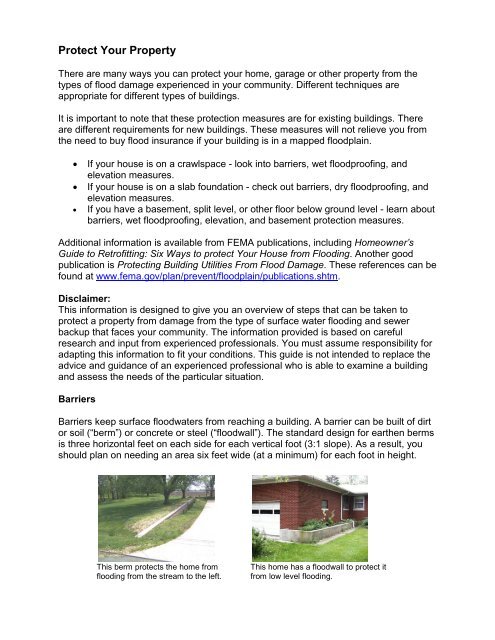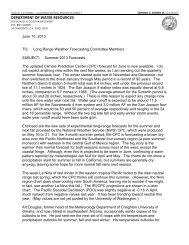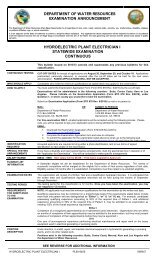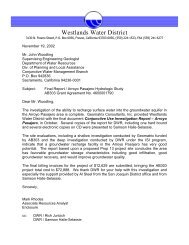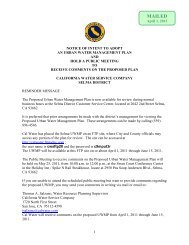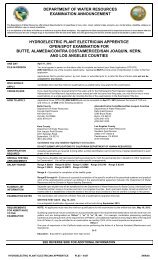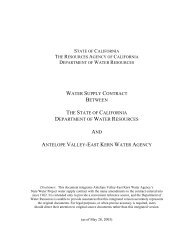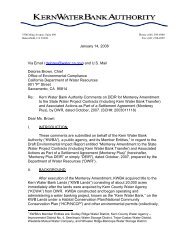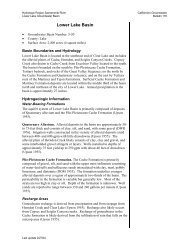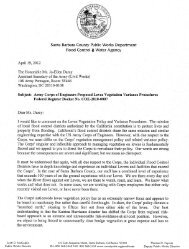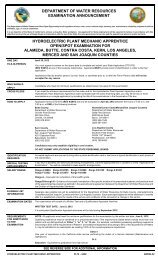Protect Your Property - Department of Water Resources
Protect Your Property - Department of Water Resources
Protect Your Property - Department of Water Resources
You also want an ePaper? Increase the reach of your titles
YUMPU automatically turns print PDFs into web optimized ePapers that Google loves.
<strong>Protect</strong> <strong>Your</strong> <strong>Property</strong>There are many ways you can protect your home, garage or other property from thetypes <strong>of</strong> flood damage experienced in your community. Different techniques areappropriate for different types <strong>of</strong> buildings.It is important to note that these protection measures are for existing buildings. Thereare different requirements for new buildings. These measures will not relieve you fromthe need to buy flood insurance if your building is in a mapped floodplain.If your house is on a crawlspace - look into barriers, wet floodpro<strong>of</strong>ing, andelevation measures.If your house is on a slab foundation - check out barriers, dry floodpro<strong>of</strong>ing, andelevation measures.If you have a basement, split level, or other floor below ground level - learn aboutbarriers, wet floodpro<strong>of</strong>ing, elevation, and basement protection measures.Additional information is available from FEMA publications, including Homeowner’sGuide to Retr<strong>of</strong>itting: Six Ways to protect <strong>Your</strong> House from Flooding. Another goodpublication is <strong>Protect</strong>ing Building Utilities From Flood Damage. These references can befound at www.fema.gov/plan/prevent/floodplain/publications.shtm.Disclaimer:This information is designed to give you an overview <strong>of</strong> steps that can be taken toprotect a property from damage from the type <strong>of</strong> surface water flooding and sewerbackup that faces your community. The information provided is based on carefulresearch and input from experienced pr<strong>of</strong>essionals. You must assume responsibility foradapting this information to fit your conditions. This guide is not intended to replace theadvice and guidance <strong>of</strong> an experienced pr<strong>of</strong>essional who is able to examine a buildingand assess the needs <strong>of</strong> the particular situation.BarriersBarriers keep surface floodwaters from reaching a building. A barrier can be built <strong>of</strong> dirtor soil (“berm”) or concrete or steel (“floodwall”). The standard design for earthen bermsis three horizontal feet on each side for each vertical foot (3:1 slope). As a result, youshould plan on needing an area six feet wide (at a minimum) for each foot in height.This berm protects the home fromflooding from the stream to the left.This home has a floodwall to protect itfrom low level flooding.
These walls were sealed with plastic sheetingcovered by brick facing for protection fromsunlight and punctures.Dry floodpro<strong>of</strong>ing is not recommended forkeeping surface water out <strong>of</strong> a basement. Thewater pressure can break the walls and floor.Precautions: It is very tempting for the owner <strong>of</strong> a dry floodpro<strong>of</strong>ed building to try tokeep the flood out if floodwaters get deeper than two or three feet. This can result incollapsed walls, buckled floors, and danger to the occupants.It is difficult to waterpro<strong>of</strong> a crawl space to protect it from underseepage. Basementsshould not be dry floodpro<strong>of</strong>ed to protect them from surface flooding because <strong>of</strong> thewater pressure on the walls and floors. See the basement protection berm for analternative approach.Many commercial waterpro<strong>of</strong>ing compounds are made to protect wood from rain, butthey will not withstand the pressures <strong>of</strong> standing water. Some deteriorate over time, socheck with the supplier to be sure the waterpro<strong>of</strong>ing compound is appropriate forsealing your basement walls from water. Installing closures and seals over doors andwindows requires enough warning and having someone at the building who knows whatto do.Wet Floodpro<strong>of</strong>ing: Wet floodpro<strong>of</strong>ing means lettingthe water in and removing everything that could bedamaged by a flood. There are several ways to modifya building so that floodwaters are allowed inside, butminimal damage is done to the building and itscontents. These techniques range from moving a fewvaluable items to rebuilding the floodprone area.In the latter case, structural components below theflood level are replaced with materials that are notsubject to water damage. For example, concrete blockwalls are used instead <strong>of</strong> wooden studs and gypsumwallboard. The furnace, water heater, and laundryfacilities are permanently relocated to a higher floor.Another approach is to raise these items on blocks orplatforms where the flooding is not deep (see photo).This wet floodpro<strong>of</strong>ed garage hasbare concrete, unfinished drywall(for fire protection) and an elevatedwater heater.
Wet floodpro<strong>of</strong>ing is not feasible for one-story houses because the flooded areas arethe living areas. However, many people wet floodpro<strong>of</strong> their basements, garages, andaccessory buildings simply by relocating all hard-to-move valuables, such as heavyfurniture and electrical outlets. Light or moveable items, like lawn furniture and bicycles,can be moved if there is enough warning. Fuse and electric breaker boxes should belocated so you can safely turn the power <strong>of</strong>f to the circuits serving floodprone areas.Another approach is to wet floodpro<strong>of</strong> a crawlspace. If your crawlspace has a furnace init or is used for storage, these items could be moved to the first or second floor. Ventsshould be placed on the foundation walls to ensure that floodwaters can get into thecrawlspace to equalize water pressure.Wet floodpro<strong>of</strong>ing has one advantage over the other approaches: no matter how littleyou do, you will reduce your potential for damage. Thousands <strong>of</strong> dollars in damage canbe prevented by simply moving furniture and electrical appliances out <strong>of</strong> a basement.Even a minor wet floodpro<strong>of</strong>ing projectwill reduce flood losses to a home.Precautions: Moving contents is dependent onadequate warning and the presence <strong>of</strong> someonewho knows what to do. Flooding a basement orgarage where there is electricity, paint, gasoline,pesticides, or other hazardous materials creates asafety hazard. There will still be a need for cleanup,with its accompanying health problems. Check localpermit requirements before moving water lines,furnaces, or electric service boxes.ElevationElevation is the most common means <strong>of</strong> reducing a building’s flood risk. The processconsists <strong>of</strong> raising the building to or above the Base Flood Elevation (BFE - thecomputed water surface elevation reached or exceeded during the 1 percent annualchance flood). When a house is properly elevated, the living area will be above all butthe most severe floods.The Federal Emergency Management Agency has approved three techniques forelevating buildings. <strong>Property</strong> owners may extend the walls <strong>of</strong> the building upward andraise the lowest habitable floor; convert the existing lower area <strong>of</strong> the house to nonhabitablespace, and build a new second story for living space; or lift the entire house(with the floor slab attached) and build a new, elevated foundation for the building.Factors to consider when selecting an elevation technique include the condition <strong>of</strong> thestructure, the source <strong>of</strong> flood hazard putting the building at risk, local floodplainregulations, and the owner’s financial resources.Precautions: When elevating, it is essential for all utilities (air conditioner, waterheater, furnace, etc.) to be elevated above the BFE. After a building is elevated, the
need to move vulnerable contents to areas above the water level during flooding iseliminated, except where a lower floor is used for storage.Additional information about elevating buildings is available online in Above the Flood:Elevating your Floodprone House or by contacting the FEMA Distribution Center at 1-800-480-2520 and requesting FEMA Document 347.BasementsBasement Plumbing: Basement flooding caused by saturated ground can <strong>of</strong>ten becorrected by installing a footing drain around the foundation (see illustration). The draincollects groundwater and directs it to a sump. When the sump fills, water is pumped out,usually onto the ground away from the building. Depending on local conditions, thedrain and pumping system may have to handle large volumes <strong>of</strong> water. Basementplumbing problems include cracks, flooding at the sump pump, and sewer backup.Typical basement drain and sewer arrangement.Note: <strong>Your</strong> floor drain may or may not be connected to the sanitary sewer line.
Basement Cracks: Groundwater can seep into your basement around pipes or throughcracks in the walls or floor. This may be difficult to determine if the walls have beencovered with paneling or other finishing. The best way to deal with a groundwaterproblem is to waterpro<strong>of</strong> the walls and relieve the water pressure through a footing drainsystem and sump as illustrated under basement plumbing. Footing drains are typicallyinstalled around the perimeter <strong>of</strong> the house, along the foundation. If this is not possible,drains can be installed on the interior <strong>of</strong> the basement, along the basement walls, anddirected toward the sump pump pit.Cracks can be repaired and the walls can be waterpro<strong>of</strong>ed from inside or outside.<strong>Water</strong>pro<strong>of</strong>ing on the outside is more effective because groundwater pressure forcesthe sealer into the foundation. The best technique is to dig a ditch around the basementwall so that you can apply an epoxy sealant to the exterior walls. This can be done bythe handyperson (many home maintenance manuals have instructions for this) or acommercial waterpro<strong>of</strong>ing company.Precautions: <strong>Water</strong>pro<strong>of</strong>ing alone is only recommended for groundwater problems.Surface water will put much more pressure on the building’s walls and can even breakthem. If the building is affected by surface flooding, you should also install a barrier orbasement protection berm.Sump Pump: Note the sump and sump pump in the basement plumbing graphic. Whenthe sump fills, water is pumped out, usually onto the ground away from the building.Depending on local conditions, the drain and pumping system may have to handle largevolumes <strong>of</strong> water.If the pump gets overloaded, or if there is a loss <strong>of</strong> power, the system designed to keepgroundwater out <strong>of</strong> your basement can act as a conduit to bring water in. You canprevent sump flooding by doing one or more <strong>of</strong> these floodpro<strong>of</strong>ing projects:Install a larger sump pumpAdd a second battery backup sump pumpBe certain that downspouts are not connected to the footing drainMake sure the downspouts drain away from the houseRedirect the downspouts and sump pump outfall farther away from the houseRun the sump pump outfall above ground level or use a check valve to preventback flowPrecautions: When there is water in your basement, it is hard to tell how it got in. It’s agood idea to check for cracks in the walls and install sewer backup protection, too.Using a battery backup sump pump is the safest alternative, plus you do not have to behome to start it. If your existing backup sump pump uses a generator for a powersource, be sure the generator is set up outside (where it won’t flood) or vented to theoutside to direct deadly carbon monoxide exhaust fumes outdoors.
Basement <strong>Protect</strong>ion Berm:Basement protection bermBasements and the lower floors <strong>of</strong> split levels can be protected from surface water byconstruction <strong>of</strong> low walls around stairwells or using backfill. <strong>Water</strong>pro<strong>of</strong>ed walls, sewerbackup protection, drain tile and a sump pump are a must. The drains and pumps cankeep up with the seepage before it gets through the berm and reaches your house.Walls are built up around the window wells and basement stairwells (don’t blockbasement windows that are needed for emergency exits). An earthen berm can be filledagainst the waterpro<strong>of</strong>ed side <strong>of</strong> the house.A subsurface drain and one or two correctly sized sump pumps are a must. The drainsand pumps can keep up with the seepage before it gets through the berm and reachesyour house.The objective is to not let floodwaters touch the house. If water on the surface <strong>of</strong> theground gets up against the house, it probably will seep down the gap between thebasement walls and the surrounding soil. This will greatly increase the amount <strong>of</strong> waterpressure against the basement walls.This house is protected by a raised stairwell anda basement protection berm covered with gravel.
Sump pumps cannot keep up with surface water. If you have sandy or permeable soil,you should consult an engineer or soils expert to ensure that the berm will extend farenough away from the walls. Note: check local permit requirements before filling orgrading a yard.Precautions: The berm can only be built so high. It can be overtopped by a flood higherthan expected. Being made <strong>of</strong> earth, it is susceptible to erosion from rain andfloodwaters if not properly sloped and covered with grass and maintained. A berm cansettle over time, lowering its protection level. The small floodwalls can crack and losetheir watertight seals.You also need to account for water in the sewer lines, footing drain and sump pumpoutfall. They may carry water under the barrier and flood inside your house.Sewer BackupAs shown in the basement plumbing illustration, the sanitary sewer line drains toiletwaste, laundry tubs, and (sometimes) the basement floor drain to the sanitary sewermain in the street. Clean stormwater and groundwater is handled by downspouts,footing drains, and sump pumps.Often basement flooding is caused by these two sewer systems being interconnected.Some houses have the downspouts, footing drain, and/or the sump pump connected tothe sanitary sewer service. During a heavy rain, stormwater enters the sanitary sewers,causing backups into one house and overloading the main lines, contributing to backupsin other houses.Don't cause your own flood! Keep your sewer lines clear!Keep roots from trees and shrubs out with root killer.Make sure your yard clean-out vent will keep debris out.Don’t pour dangerous liquids down the drain (motor oil, paint, pesticides,poisons, epoxies, etc.).Don’t pour grease, fat or cooking oil down the drain (they solidify later).Don’t flush large solids, such as diapers, down the toilet.Sewer backups can also be caused by events not related to storms or flooding.Individual service lines can be plugged by grease, waste, tree roots, breaks in the pipe,or saturated ground. Proper maintenance, like pouring tree root killer down the toilet orfloor drain can prevent most <strong>of</strong> these problems.The sewer mains can also be plugged by the same causes, or by vandalism or illegaldumping in manholes. These problems can be fixed by the owner or the community,depending on where the stoppage occurs.
There are four ways to stop sewer backup that occurs when the sewer main isoverloaded and backs up through the sanitary service line into the house: floor drainplug, floor drain standpipe, overhead sewer, and backup valve. Each <strong>of</strong> these measureswork for buildings with basements or below-grade floors.Floor Drain Plug: The simplest way to stop sewer backup is to plug the opening whereit first occurs (see the basement plumbing graphic). This is at the floor drain, thesanitary sewer system’s lowest opening in the house. Two inexpensive measures canbe used: a plug or a standpipe. Both can be purchased at local hardware stores and areeasy for the handyperson to install.The flood drain plug stops water from flowing in eitherdirection. Therefore, if the laundry tub overflows or otherspillage occurs, it will stay in the basement unless the plug isremoved. Because <strong>of</strong> this, it may be best to leave the plug outunder normal circumstances and put it in place only duringheavy rains.Floor drain float plug One variation is a plug with a float. It allows water to drain out<strong>of</strong> the basement (see illustration, left side). When the sewerbacks up, the float rises and plugs the drain (see illustration, right side). A float plugpermanently installed will not interfere with the floor drain’s normal operation.Precautions: A plug left in the floor drain may contribute to a wet basement if waterfrom a laundry tub spill or a leaky pipe cannot drain out. Float plugs are known to havebeen jammed open by a small amount <strong>of</strong> debris. A plug does not tell you if there is aproblem in your sewer service line. If the plug is not tight enough, pressure can eject it.Therefore, a plug is not recommended for flood depths greater than one foot.Standpipe: A standpipe is an inexpensive alternative to a floor drainplug. When the sewer backs up, the water moves up the pipe. Ifproperly installed, water pressure cannot build up to blow a standpipeout <strong>of</strong> the floor drain. The system works unless the backup is so deepthat it goes over the top <strong>of</strong> the pipe.Precautions: Neither the plug or standpipe stops backup from comingout <strong>of</strong> the next lower opening, like a laundry tub or basement toilet.Sealing the base <strong>of</strong> the toilet to the floor will protect you until the waterbacks up higher than the top <strong>of</strong> the bowl.Because water pressure depends on the height <strong>of</strong> water in the pipes, astandpipe does not reduce the pressure in the pipes (or under the floor,if the pipes leak). Because the pressure under the floor is the same with a standpipe ora plug, standpipes and plugs are only recommended for flood depths <strong>of</strong> one foot or lessand for buildings with cast iron sewer lines underneath the floor.
Overhead Sewer: An overhead seweris generally viewed as the mosteffective sewer backup protectionmeasure. It acts like a standpipe butwithout the shortcomings. A sump isinstalled under the basement floor tointercept sewage flowing frombasement fixtures and the basementfloor drain. An ejector pump in thesump pushes sewage up above theflood level. From there it can drain bygravity into the sewer service line.Plumbing fixtures on the first floorcontinue to drain by gravity to theservice line.Overhead sewer arrangementUnless the house is subject tooverbank flooding, it is unlikely that the sewers will back up above ground level. If waterdoes go higher, a check valve in the pipe from the ejector pump keeps it in the pipes.Backed up sewage is enclosed in the sewer pipes and doesn’t overflow laundry tubs orbasement toilets.Although more dependable than a standpipe, an overhead sewer is more expensive. Aplumbing contractor must reconstruct the pipes in the basement and install the ejectorpump. It can cost $3,000 to $7,000.Precautions: The ejector pump requires electricity to work, so battery backups arerecommended. The basement is disrupted during construction and the ejector pumpneeds periodic maintenance. Note: This work requires a licensed plumber; check localpermit requirements before starting.Sewer Backup Valve: A backup valve stops the water in the sewer pipes. While not asfoolpro<strong>of</strong> as an overhead sewer, installation is less disruptive to the basement.Older versions <strong>of</strong> thisapproach were located inthe basement floor andrelied on gravity to closethe valve. If debris gotcaught in the flapper, thevalve did not close tight.Because <strong>of</strong> itsunreliability, valves werediscouraged and evenprohibited in somecommunities. Today’ssystems are moresecure. They include
installing two valves in line, using better, more watertight materials, or counterweightsthat keep the valve open all the time so debris won’t catch and clog it.Larger valve systems are usually installed in a manhole in the yard, well away from thebasement wall, so there is less disruption during construction and no concerns overbreaking the pipes under the basement floor. The cost <strong>of</strong> this type <strong>of</strong> backup valve iscomparable to the cost <strong>of</strong> an overhead sewer, in the $4,000 to $6,000 range.Precautions: The ejector pump and the valve require maintenance. Note: This workrequires a licensed plumber; check local permit requirements before starting.For more detailed information on protecting your home, visit the Repetitive Flood Portalat http://www.floodhelp.uno.edu/Portal.aspx?ContentID=13.


